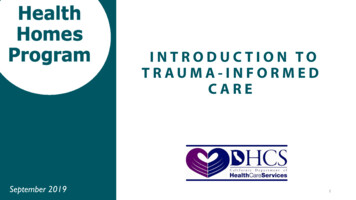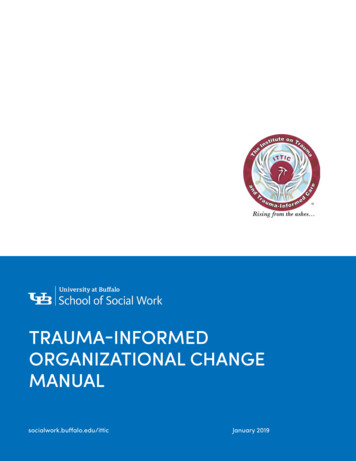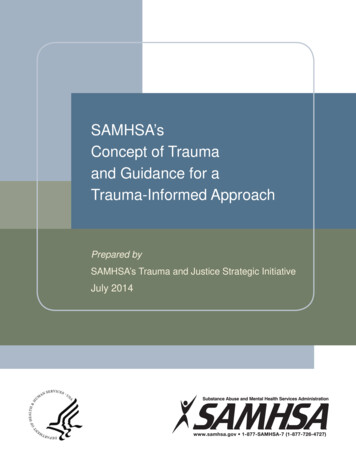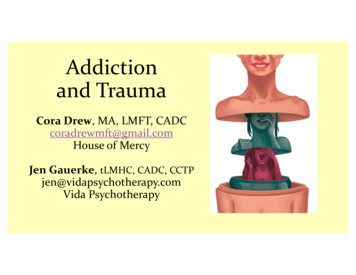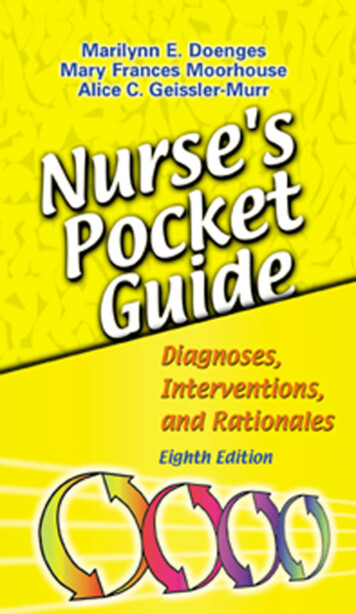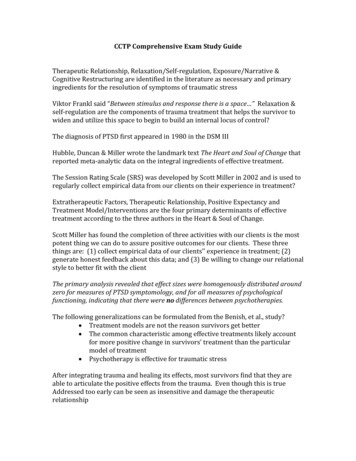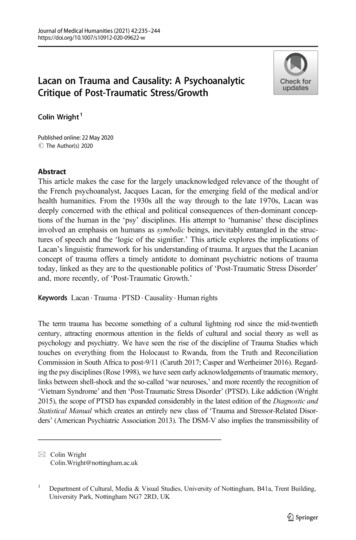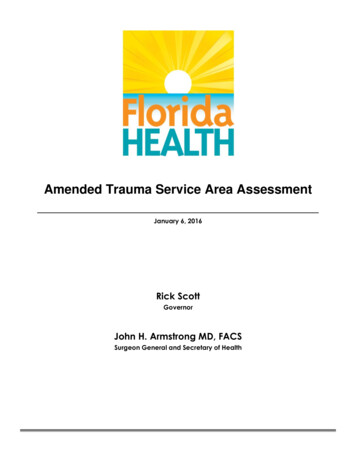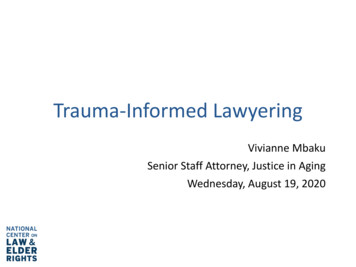
Transcription
Trauma-Informed LawyeringVivianne MbakuSenior Staff Attorney, Justice in AgingWednesday, August 19, 2020
About NCLERThe National Center on Law and Elder Rights (NCLER) providesthe legal services and aging and disability communities withthe tools and resources they need to serve older adults withthe greatest economic and social needs. A centralized, onestop shop for legal assistance, NCLER provides Legal Training,Case Consultations, and Technical Assistance on Legal SystemsDevelopment. Justice in Aging administers the NCLER througha contract with the Administration for Community Living’sAdministration on Aging.2
Presentation Goals Define Trauma-Informed Lawyering Discover benefits of Trauma-Informed Lawyering Learn best practices Provide space to reflect on trauma-informedpractices and vicarious trauma3
What is Trauma-InformedLawyering?
What is Trauma? (1 of 2) Trauma is an event that “renders an individual’sinternal and external resources inadequate, makingeffective coping impossible .A traumaticexperience occurs when an individual subjectivelyexperiences a threat to life, bodily integrity, orsanity.” Sarah Katz & Deeya Haldard, The Pedagogy of TraumaInformed Lawyering, 22 Clinical L. Rev. 359, 364.5
What is Trauma? (2 of 2) As public interest lawyers, we must remember Trauma is in the eye of the beholder . Adriel Boals, Trauma is in the eye of the beholder:Objective and subjective definitions of trauma, Journalof Psychotherapy Integration (2018)6
How Common is Trauma? (1 of 2) Trauma is very common, with a 1997 NIH studyfinding about 1/3rd of the population willexperience severe trauma at some point A majority of Americans experience violent crime intheir lives 12 million women have been victims of rape 3 million children a year “are reported as victims ofchild abuse and neglect”-The Body Keeps the Score, Bessel Van Der Kolk, M.D.7
How Common is Trauma? (2 of 2) Who experiences trauma? 5% of men and 10-12% of women will suffer from PTSDin their lives. New research connects higher rates of PTSD amongracial and ethnic minorities to experience of racism As legal services attorneys, you interface withpeople and their traumas on a daily basis, in everypractice area8
Trauma and Older Adults How does trauma intersect with old age? Adverse childhood experiences (ACE’s) leads toincreased frailty in old age ACE’s are traumatic events, like the death of a parent,drug/alcohol abuse in the family, physical abuse The Kaiser Study found that children with more ACE’shad poorer health and social outcomes in adulthood ACE’s also associated with increased risk of prematuredeath ACE study consisted of majority white middle class studyparticipants9
Trauma and Our Clients (1 of 3) Trauma has a direct impact on the brains of thosewho experience it The brain’s prefrontal cortex—which is key to decisionmaking and memory—often becomes temporarilyimpaired. The amygdala, known to encode emotionalexperiences, begins to dominate, triggering the releaseof stress hormones and helping to record particularfragments of sensory information. Victims can alsoexperience tonic immobility—a sensation of beingfrozen in place—or a dissociative state. The physiological effects of trauma can occur a longtime after the traumatic experience has ended.10
Trauma and Our Clients (2 of 3) In PTSD patients, trauma can change the functioning of thestress hormone system. “Fight/flight/freeze signals continueafter the danger is over [i]nstead, the continued secretionof stress hormones is expressed as agitation and panic and,in the long term, wreaks havoc with their health” In fact, “re-exposure to a similar environment” can create a“recurrence of fear and anxiety similar to what wasexperienced during the trauma itself.” Repeatedly raising the adrenaline of a person through a traumaticexperience can cause wear and tear on the body 22 Clinical L. Rev. 359, 366. Article: Vets Experiencing Trauma Can't Respond to Reason The Body Keeps the Score11
Trauma and our Clients (3 of 3) Trauma reorganizes the way the mind and brainmanage perceptions Trauma inhibits the ability of your “left brain” (logic)and “right brain” (creativity) to work together. Traumacan “deactivate” the left brain, which “has a directimpact on the capacity to organize experience intological sequences and to translate our feelings intowords. The left frontal lobe (Broca’s area) can shut down whenconfronted with trauma. The Broca’s area helps you put your thoughts into words This area is sometimes impaired during a stroke12
How Trauma Effects the LawyerClient Relationship Effective communication Lawyer-client trust Getting all of the facts Prepping clients for the witness stand Effective representation Achieving desired outcomes13
Trauma-Informed Lawyering (1 of 2) We honor the lived experiences of our clients andsupport their healing by acknowledging the waystrauma has impacted their lives. Legal advocacy may often relate to the client’straumatic event. Trauma-informed care is looking at a person andnot asking “What is wrong with you?”—it’s asking“What happened to you?”Trauma Informed Legal Advocacy Project (TILA)14
Trauma Informed Lawyering (2 of 2) “Providing trauma-informed services requires allthe staff of an organization to understand the effectof trauma on the people being served, so that allinteractions with the organization reduce thepossibility of re-traumatization and are consistentwith the process of recovery.”22 CLINICAL L. REV. 359, 369.15
Benefits of Trauma-InformedLawyering
Benefits of Trauma-InformedLawyering Reducing re-traumatization Better advocacy Better referrals Discovering additional legal issues Builds trust Overall enhancement of the lawyer-client relationshipAs we will see, you are probably already using some ofthese tools in your daily practice17
In Practice
2 Step ProcessSTEP 1 Identify the Trauma Is case related to apossibly traumaticincident? Client might explicitlyrefer to trauma Read body language Is client closed off,agitated, anxious? Frustration? Anger? Unable to answerquestions?STEP 2 Adjust relationship Adjust the lawyer-clientrelationship in relation tothe trauma Adapt lawyering strategiesto make client morecomfortable Acknowledge the trauma Notice and validatefeelings22 CLINICAL L. REV. 359, 383.19
Strategies for Trauma-Informed Work(1 of 4) Transparency Promotes trust with the client Minimizes the feeling of “powerlessness” Minimizing powerlessness helps clients feel in controland helps regulate emotions Client Control Remind your client that they have a voice, this is theircase as much as it is yours Remember your ethical duties to follow client, andinform your client of these duties20
Strategies for Trauma-Informed Work(2 of 4) Predictability/Minimize Re-Traumatization Preview what is going to happen throughout the case—when might they have to recount a traumaticexperience? Preview meeting topics with clients. Let them knowwhen they may have to recount a traumatic experience. Stay organized and take complete notes so you don’thave to ask hard questions more than needed. Manage expectations—what can you actually do? Whatcan’t you do?21
Strategies for Trauma-Informed Work(3 of 4) Reliability Don’t make promises you can’t keep and be clear. Manage expectations about communication & how longthe case will take. Patience/Empathy Don’t yell at your clients! Resist urge to judge the behavior of a client. Askyourself, what would you do if in the same situation?Does their behavior seem more reasonable? Sometimes, someone just isn’t ready. Do you make itclear you have an open door? Acknowledge the obstacles that you can’t control in thecase, i.e delays with the court or opposing counsel.22
Strategies for Trauma-Informed Work(4 of 4) Honoring Your Client’s Lived Experiences Acknowledge your client’s lived experience, i.e.racism, poverty, disability, homophobia. Thesetraumas inform the way our clients interact with usand the world. Acknowledge their existence andaffirm your client’s experiences. Cultural competency goes hand-in-hand withtrauma-informed practice.23
How Are Attorneys Affected? As lawyers, we are not immune to the suffering ofothers, and we can have reactions from being exposedto the trauma of our clients. A “trauma exposure response” can manifest in severalways, for example: HopelessnessHypervigilanceDiminished CreativityInability to ListenFeelings that you can never do enoughChronic ExhaustionFear and GuiltInability to EmpathizeTrauma Stewardship by Laura van Dernoot Lipsky and Connie Burk24
Vicarious Trauma You may have heard of “burnout,” “vicarioustrauma,” and “compassion fatigue” These are all different names for the samesymptoms that can result not only from listening toothers describing their trauma but also from“merely working in an office where others aresuffering from [vicarious trauma]”- ABA This means everyone in your office is at risk, andeveryone is a part of the solution25
Combatting Secondary Trauma (1 of 2) Reflective practice keeps compassion in your work Reflective practice “means regularly engaging in reflection, both in thecontext of individual interaction and after big successes or losses.”–Trauma Informed Legal Advocacy Project (TILA) Consider creating small group sessions where staff can support eachother and discuss difficult cases or clients. Encourage Self-Care Do staff feel comfortable taking time off? Does anyone take a vacation? Are staff working normal hours? Is there a culture of always workingextreme hours? Do staff come in even when they are sick? This is especially relevant inlight of COVID-19. Supporting Staff What is your org culture around vacation and sick time?Can you easily express when you have too much on your plate?How is work assigned? Are managers monitoring workloads?Is there space for reflection?26
Combatting Secondary Trauma (2 of 2) Additional considerations for legal aid organizations Does your organization, or state bar, have an EmployeeAssistance Program? These programs can offer free,confidential counseling to staff experiencing manydifferent types of crises. If you do not have this program, you should consider investingin this type of support and encouraging staff to participate. Be open to change. Many of the trauma-informedstrategies may be the opposite of how you are used tooperating, but will be incredibly beneficial to staff. Most of these changes are going to be made at themanagerial level, therefore it is important for managersto be engaged in this work as well.27
Remember! Trauma Informed Lawyering does not include: Diagnosing anyone or being your client’s therapist (makeappropriate referrals to mental health services) Trying to “fix” someone Do you know where to refer clients for mentalhealth services?TILA28
Example 1 Len is a new client coming in for assistance with a debtcollection case. You are running a bit late on time so youjump into questioning as soon as he sits down. As youask him questions you realize his leg is literally“jumping” he is shaking so much. His answers are shortwith little detail. He seems a bit withdrawn and keepslooking towards the door.29
Example 1 Steps Identify the trauma Observing bodylanguage, there seemsto be some anxiety ortension He’s giving shortanswers, but it seemshe’s holding back moreinformation Trauma is not obvious Adjust Relationship Acknowledge client’sreactions, “You seem abit uncomfortable, isthere anything I can doto make you morecomfortable?” “Let’s back up, let meexplain what I can helpyou with.”30
Example 1 Continued You stop legal questioning and note that he seemsuncomfortable. You realize that you jumped into the interviewwithout really explaining your role or what you will be doingtoday. You acknowledge that Len seems uncomfortable and ask if thereis anything you can do to make him more comfortable. Len shares that he was a victim of torture in his home countryand feels tremendous anxiety when he is seated so far from thedoor. He also does not like being in rooms with closed doors as hefeels he cannot escape. You readjust the seating and move to the open conference roomin your office. You tell Len that if he has any other concerns to letyou know. You then explain the process and what will happen at thisinterview. You let Len know that if he needs break or anythingelse to let you know.31
Example 2 Sarah has come to your office for assistance with anelder abuse protective order. Her youngestdaughter was her caregiver but began assaultingher and denying her food. Sarah has been verynervous about the hearing because she knows shewill have to confront her daughter and testify aboutthe abuse. Sarah has also started to get cold feet aboutpursuing the protective order. She doesn’t want herdaughter’s employment opportunities to beimpeded and she still wants to have a relationshipwith her.32
Example 2 Steps Identify the trauma Traumatic experience inpast is confirmed Physical and emotionalabuse Adjust Relationship Help client get“grounded” and in thepresent moment Anticipate what mighthappen in court Provide a tour of court Are there others that canalso provide support? What would be yourapproach to Sarah notpursuing the protectiveorder?33
Example 2 Continued First, you acknowledge that this hearing might be bringing upsome anxiety for Sarah, but that you will help her prepare. To prepare Sarah, you have given her a full walk-through of whatwill happen at the hearing and the types of questions that will beasked. Sarah is also prepared to request a break if the hearingoverwhelms her. Sarah knows where the court is and where and what time tomeet you. Sarah has also taken your advice and spoken to her therapist inpreparation for the hearing so that her anxiety is managed. You speak with Sarah about her concerns about her relationshipgoing forward with her daughter. You remind Sarah that you arethere to help her have a safe future, but it is up to her whethershe pursues the order.34
Best Practices Take the time to make yourclient comfortable Engage in reflectivepractice and encourageothers to do so Practice empathy Be transparent to buildtrust Listen to your clientOffer accommodationsWhere available, be flexibleOffer breaks or haveshorter meetings withclients Ex. Explaining simple thingslike why you are takingnotes, what the client canexpect from yourrelationship Lawyers are notorious fornot explaining fully to clients35
What’s Next? Do you have a reflective practice? If you are in a management position, how can youestablish an organized reflective practice? What trauma-informed practices do you think youcan implement in your work? Or have you already implemented these practices? What would you change to implement moretrauma-informed practices in your workplace?36
Additional Resources National Center on Domestic Violence, Trauma &Mental Health: Trauma Informed Legal Advocacy (TILA)Project The Jewish Federations of North America: Center forAdvancing Holocaust Survivor Care The Pedagogy of Trauma-Informed Lawyering, 22CLINICAL L. REV. 359, 363 Establishing a Trauma-Informed Lawyer-ClientRelationship, ABA Child Law Practice , Oct. 2014 The Body Keeps the Score, Bessel Van Der Kolk Trauma Stewardship, Laura van Dernoot Lipsky withConnie Burk37
Questions?38
Visit Our Website: ncler.acl.gov39
Elder Justice About-Elder-Justice-Toolkit.aspx40
Case ConsultationsCase consultation assistance is available forattorneys and professionals seeking moreinformation to help older adults. ContactNCLER at ConsultNCLER@acl.hhs.gov.41
-The Body Keeps the Score, Bessel Van Der Kolk, M.D. 7. How Common is Trauma? (2 of 2) Who experiences trauma? 5% of men and 10-12% of women will suffer from PTSD in their lives.



